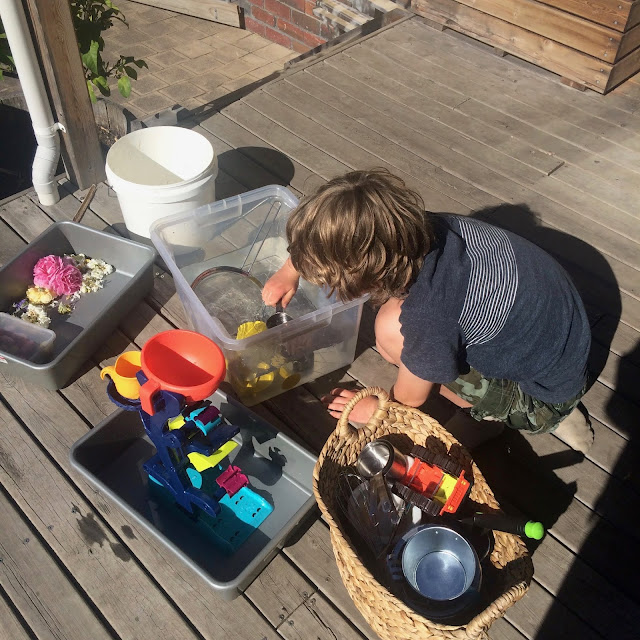Last year I had an epiphany that has really changed my life: Backyard stations are the solution to all my problems.
Well, maybe not all my problems, that's a big ask, but they do encourage prolonged outdoor play and who doesn't want more of that?!
Following are the stations I've been setting up for my kids.
Following are the stations I've been setting up for my kids.
Now that I have collected all the items for the stations, it only takes a few minutes to set them up, and they result in hours of extended play. They also promote an active lifestyle and healthy child development (Australian Curriculum, Health and PE).
We went 'screen free' these past holidays so it was good to have some outdoor ideas in my arsenal. The transition to 'screen free' turned out to be really easy for us.
We went 'screen free' these past holidays so it was good to have some outdoor ideas in my arsenal. The transition to 'screen free' turned out to be really easy for us.
This station has shovels, buckets, a pick axe and trowels. We're big fans of these Ames shovels.
Once in a while I leave the hose on for a bit to create a mud pit.
It's great fun to bounce straight off the trampoline into knee-deep mud... and my kids love digging for 'treasure'.
Muffin pans and natural items make nice additions to this station.
2. Water play
As well as putting out measuring equipment and water toys, I snip some flowers and herbs for this station.
Chalk, a hammer, mortars and pestles offer extra play possibilities. The chalk can be crushed and mixed with water to create paint or used straight on the pavers.
Sometimes my sons ask for cloth to dye with flowers or spices to grind up.
3. Trestle table
On a table I put some easy art or science activities, such as our DIY science kit, watercolour paints, a nature tray with magnifying glass, playdough, or seeds for bird pizzas.
My kids are really too old for this, but they can still be enticed... the trick is to call it 'diorama creation'. *Smug smirk*
Both my boys have enjoyed making biomes and habitats for plastic animals at different times. You could add dinosaurs, diggers, fairies...
5. Gardening
My sons are sometimes in the mood to earn extra pocket money by pulling weeds. They also LOVE cutting up large pieces of garden waste with loppers and the saw.
6. Rugs and cushions
If I leave out a picnic rug, my oldest will invariably bring out his current book to just chill. As well as rugs and cushions, I have a double sleeping bag dedicated to outdoor use.
I'm into meditation at the moment and quite enjoy using these cushions and rugs to meditate outdoors.
I'm into meditation at the moment and quite enjoy using these cushions and rugs to meditate outdoors.
7. A strategy game
We keep a congklak board outdoors. (My son is making these to sell so if you want one message me through the address in my profile. Post coming soon about congklak).
8. Whittling
This is something we're only just getting into: For Christmas my son Roo got some whittling books - Forest Craft by Richard Irvine, The Little Book of Whittling - and an Opinel No.7 knife. You can also get an Opinel with a round tip, but we went with the sharp tip.
9. Fire
We have an antique Italian brazier called a frascera which we use when the weather is cold. The kids love to toast things on it or occasionally cook in it. We also sometimes share poetry and stories around it.
When it's hot I have been known to put out block play instead. We have some tree blocks (similar here) but be warned, they make much more mess than regular blocks!
10. Painting
I usually only set up our easel when we have younger cousins or friends to visit. I put a low table next to it with paints, sponges, trays, brushes, sticks and rubber bands for making nature brushes.
11. Nature study
Just inside the door I sometimes put a bowl with basic nature study tools such as a microscope, motion camera, guide books and a bug box.
Shelley is a guts
Plus... our yard also has some permanent features:
- a cubby with a rope ladder
- a tree to climb
- a trampoline
- bikes
- a box of sports equipment
- a box of loose parts (like tarps, sheets, ropes, pulleys, tubes...)
- a hanging xylophone
- an insect hotel
- logs and stumps
- our 'corner office'.
And of course we have fruits, veggies and herbs that my youngest son loves to tend and eat.
I'd love to know what you do outdoors. Please tell us in the comments.
Thanks for stopping by. Looking for more outdoor ideas? Try these:
- Epic Kids' Outdoor Bucket List (100 Things!)
- Nature Study Backpacks + Tassie Nature Apps
- Quest for the Best Birdfeeder
- Easy, Cheap and Fun Way to Learn to Tell the Time




































































